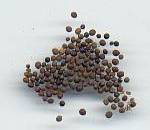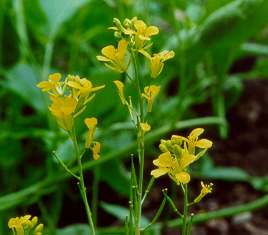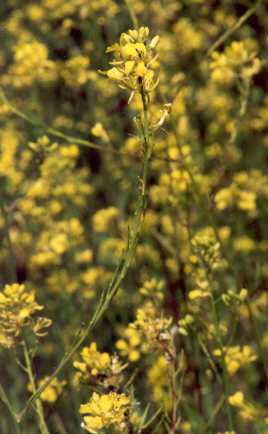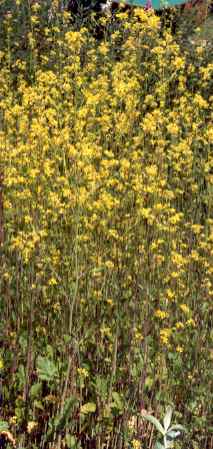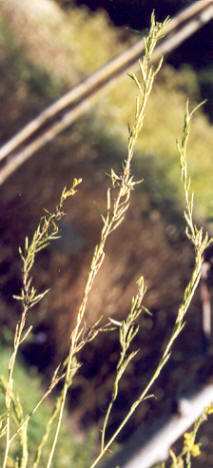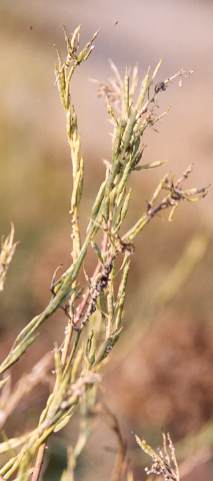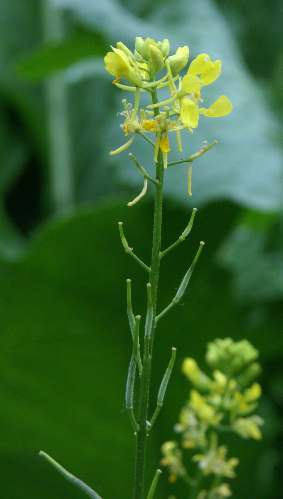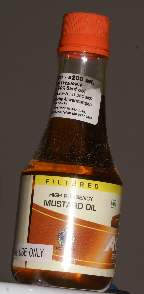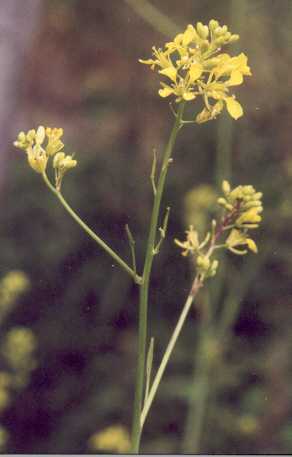
|
| Flowering black mustard |
There are, however, also mustard types made from a mixture of black and white mustard seeds, and some very pungent specialty mustards ndeed contain pure black mustard seeds. In order to keep the pungency stable, these stronger mustard pastes usually contain more acidic components than the milder products based on white mustard seeds. See white mustard for more information on mustard pastes. See also negro pepper for a comparative review on pungent spices.
Black mustard is more important as a spice and oil plant, especially in India (see also sesame about vegetable oils in general). Indian mustard oil is really essential for the authentic flavours of several Indian regional cuisines; it is widely used in Kashmir, Maharashtra and neighbouring Goa (see tamarind for the famous Goan pork curry vindaloo [विंदालू] which also uses mustard oil).
The epicenter of mustard oil usage, however, is the Indian union state West Bengal and Bangladesh, where it is known as sarisar tel [সরিষার তৈল] It is the preferred cooking medium and contributes a characteristic flavour which is particularly noticeable as intensive spices are used with moderation in Bengali cooking (see also nigella).
Mustard oil produced in Bengal often contains enough isothiocynates to have a pungent mustard flavour and is often
used as a flavouring, e. g., by dribbling the oil over boiled vegetables before
serving. It is also used in pickled raw vegetables (achar [अचार]), where
it contributes pungency and acts as a preservative.
Such oil is difficult to obtain outside of India, and people in the
West will have to substitute it by mustard paste (preferably of
dijon type, see white mustard) or
mustard powder (of the Colman type, see also white
mustard); I wonder whether freshly grated horseradish might also work.
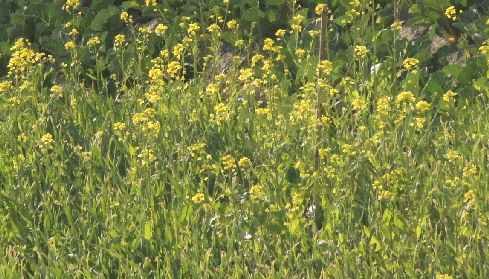
|
| Mustard field in Nepal |
The Indian subcontinent knows of another special quality of mustard oil: In the Newar-
However, because of the erucic acid and maybe also the isothiocyanates, mustard
oil is not a legal foodstuff in most western countries, including the EU and
the USA, and it must not be sold as cooking oil. Nevertheless, Indian food
shops often sell mustard oil, but to circumvent these paternalistic laws, their
mustard oil is labelled
In North and particularly South India, black mustard seeds are directly used as a spice. They are
always fried in fat, or dry-
Black mustard seeds are also a component in the Bengali spice mixture
panch phoron (see nigella)
and the South Indian composition sambar podi (see
coriander). In both cases, the mustard seeds receive the usual heat treatment
either during the preparation of the spice mix, or later in the cooking process.
Raw mustard seeds with all the pungency retained are rare in India;
yet a fresh-made paste from ground mustard seeds and water is common in Greater Bengal,
the spice mango pickle avakaya [ఆవకాయ]
from Andhra Pradesh in South India.
In Western cooking, black mustard seeds are more rarely used as a spice. If tried,
they should be crushed and soaked in water to give an improvised mustard paste,
or added in the ground state. Note that boiling inactivated the enzymes necessary
for the formation of the pungent taste, and therefore it hardly makes sense to add
intact mustard seeds to boiling foods; also, if the flavour is allowed to develop in the cold,
heating will quickly destroy the already formed isothiocyanates. Yet ground dry or moist
mustard seeds can be effective if addeded to cold or lukewarm foods, and will then display an
unusual mustard flavour. They should be added as late as possible if some traces of mustard
pungency are desired.
For external use only
. There is no need to take
that remark seriously, although mustard oil does have cosmetic use in India
(e. g. as hair balm). In India, it is common to heat mustard oil initially to
high temperature, up to the smoking point, and let it then cool down to regular
cooking temperature, or even to room temperature, before the cooking proceeds.
Although I don’t know for sure, this heating procedure might be useful for
detoxification (or, maybe, it just improves the taste, as does the
toasting of dry spices); in any case, it’s a good idea to follow that praxis.
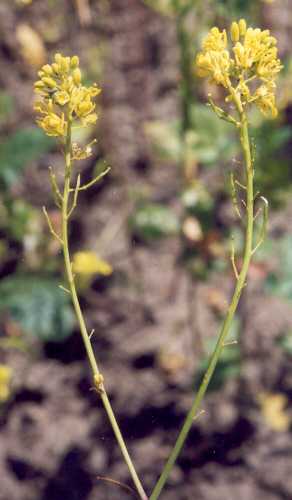
Black mustard flowers
